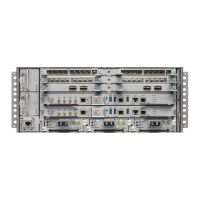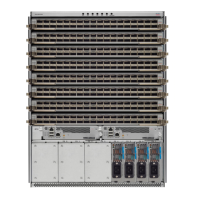PurposeCommand or Action
RP/0/RP0/CPU0:router(config-ospf)# timers lsa
• The default is 1800 seconds for both OSPF and
OSPFv3.
refresh 1800
Limits the frequency that new processes of any particular
OSPF Version 2 LSA can be accepted during flooding.
timers lsa min-arrival seconds
Example:
Step 6
• The default is 1 second.
RP/0/RP0/CPU0:router(config-ospf)# timers lsa
min-arrival 2
Changes the interval at which OSPF link-state LSAs are
collected into a group for flooding.
timers lsa group-pacing seconds
Example:
Step 7
• The default is 240 seconds.
RP/0/
/CPU0:router(config-ospf)# timers lsa group-pacing
1000
commit
Step 8
Creating a Virtual Link with MD5 Authentication to Area 0 for OSPF
This task explains how to create a virtual link to your backbone (area 0) and apply MD5 authentication. You
must perform the steps described on both ABRs, one at each end of the virtual link. To understand virtual
links, see Virtual Link and Transit Area for OSPF, on page 268 .
After you explicitly configure area parameter values, they are inherited by all interfaces bound to that
area—unless you override the values and configure them explicitly for the interface. An example is provided
in Virtual Link Configured with MD5 Authentication for OSPF Version 2: Example, on page 339.
Note
Before you begin
The following prerequisites must be met before creating a virtual link with MD5 authentication to area 0:
• You must have the router ID of the neighbor router at the opposite end of the link to configure the local
router. You can execute the show ospf or show ospfv3 command on the remote router to get its router
ID.
• For a virtual link to be successful, you need a stable router ID at each end of the virtual link. You do not
want them to be subject to change, which could happen if they are assigned by default. (See OSPF
Process and Router ID, on page 263 for an explanation of how the router ID is determined.) Therefore,
we recommend that you perform one of the following tasks before configuring a virtual link:
• Use the router-id command to set the router ID. This strategy is preferable.
• Configure a loopback interface so that the router has a stable router ID.
• Before configuring your virtual link for OSPF Version 2, you must decide whether to configure plain
text authentication, MD5 authentication, or no authentication (which is the default). Your decision
determines whether you need to perform additional tasks related to authentication.
Routing Configuration Guide for Cisco NCS 6000 Series Routers, IOS XR Release 6.4.x
292
Implementing OSPF
Creating a Virtual Link with MD5 Authentication to Area 0 for OSPF

